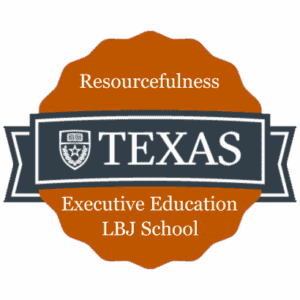The Resourcefulness Digital Badge
The Resourcefulness Digital Badge from The University of Texas at Austin is designed for learners and professionals who want to deepen their knowledge of energy and water - and put that knowledge to work for a sustainable future.

Who is a Digital Badge For?
- Students preparing for careers in STEM, sustainability, or public service
- Educators looking for free professional development
- Professionals in energy, water, utilities, or infrastructure
- Policymakers and civic leaders shaping sustainable communities
- Corporate teams focused on ESG and sustainability initiatives
- Lifelong learners curious about the environment and innovation
Earn a credential that demonstrates your expertise, grows your impact, and positions you to lead in the transition to a smarter, more sustainable world.
What is a Digital Badge?
A digital badge is a modern, verifiable credential that shows off your skills and achievements. Unlike a paper certificate, digital badges live online — making them easy to share, display, and verify.
- All University of Texas at Austin badges are issued through Canvas Credentials (formerly Badgr).
- Each badge contains metadata: details about what you learned, who issued it, and the standards or competencies it represents.
- You can display badges on LinkedIn, digital resumes, email signatures, e-portfolios, or even download a printable certificate.
Earning a Resourcefulness Digital Badge proves you understand the energy–water connection and are ready to apply conservation and sustainability skills to make an impact.


Why Earn a Digital Badge?
Digital badges add real value because they bridge the gap between education and the workforce. Here’s why they matter:
1. Proof of Skills (Not Just Attendance)
- Badges don’t just show that you “took a class.” They highlight what you can actually do — conservation strategies, leadership skills, understanding the energy-water nexus, etc.
- Employers increasingly look for skills-based evidence, and badges offer that in a portable format.
2. Portable and Shareable
- You can embed your badge on LinkedIn or include it in your digital portfolio, instantly signaling credibility to employers, colleagues, and peers.
- Unlike a transcript or degree, badges are clickable: anyone can see the competencies and issuing institution.
3. Future-Proof Learning
- Badges support lifelong learning – you don’t need to wait for a full degree to show your progress.
- They’re “stackable”: multiple badges can add up to a bigger credential, like a certificate program or even count toward professional development requirements.
4. Workforce Relevance
- In sectors like energy, water, sustainability, and leadership, badges signal that you’ve acquired future-ready skills – useful for hiring managers, HR administrators, and promotion committees.
- They help address the skills gap by quickly validating niche competencies that a traditional degree may not highlight.
5. Credibility & Recognition
- Badges from institutions like the LBJ School at UT Austin carry brand weight and academic authority.
- They demonstrate you’ve been trained by a trusted institution – which carries more influence than generic online courses.